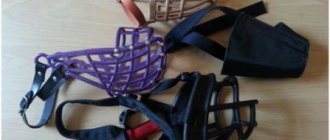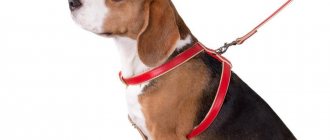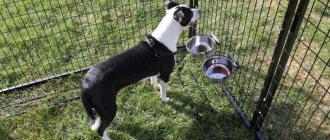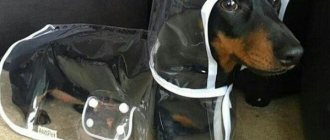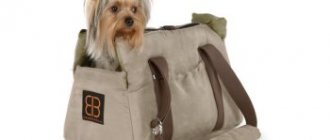The East European Shepherd is a large breed of dog, so it is often used as a guard on the site. The best living conditions in this case are housing in the form of a booth installed in an outdoor enclosure.
This type of booth can be made for a shepherd
Drawings and dimensions
In order for the construction to be successful, it is important to correctly calculate the size of the booth for the East European Shepherd, as well as the area of the enclosure. To do this, you must first measure the animal - body length from nose to tail, height at the withers. 15 cm is added to these values - this is how you will find out the appropriate size of the booth for VEO. The width of the dog's chest will be needed to calculate the width of the entrance hole - add 5-8 cm to the resulting figure. To find out the height of the opening, subtract 10 cm from the height at the withers.
Often, at the time of construction, the dog is still small and the owners do not know what size booth it will need. Then it is better to take the advice of breeders and take standard sizes as a basis:
- length - about 115-120 cm;
- width - 65-85 cm;
- booth height - 80-90 cm;
- hole size - 35x55 cm.
Booth parameters for the East European Shepherd
This kennel size should be suitable for an adult shepherd.
The area of the enclosure should not be less than 4 square meters, otherwise it will negatively affect the health of the animal. The enclosure can be either closed or without a roof. Small buildings usually have one or two blank walls for protection from wind.
IMPORTANT: If you want to provide your dog with more space to move, it is better to build an enclosure with a size of 8 square meters or more. Sometimes an option is used with a fence that covers the perimeter of the site with a corridor - this way the shepherd dog can make up for the lack of movement and control the entire territory.
Calculating the size of the enclosure and preparing a drawing
Every dog breeder will be able to draw up a construction project. The dog enclosure consists of three parts. Shepherd sizes:
- winter road - a closed, insulated space measuring 2x1.5 m on which the booth is located;
- platform - wooden flooring with an area of 2x1.5 m;
- a walking area measuring 2x1 m. You can compact soil on the floor or put together a wooden flooring.
A small manhole should connect the winter road to the platform. Through it, the dog will be able to climb into the kennel, and the owner will put bowls of food for it. You need to make an entrance door on the outside wall. The width of both holes should be 80 cm.
Drawing (side view)
The height of the house should be 180 cm or more. The roof must be placed at an angle so that rainwater drains from it. You will also need a visor.
Knowing the requirements for building an enclosure, the owner will be able to design the correct drawing and build the house with his own hands.
The diagram above shows the location of the booth in the winter road, as well as the outer and inner doors.
Important! If two dogs live in the enclosure, then the area needs to be increased by 1.5 times.
DIY enclosure for an East European Shepherd
For construction, you can take a ready-made project, or develop a construction scheme yourself.
Drawing with dimensions of the enclosure for Veo
Once the drawing is ready, you can start working:
- If the enclosure for VEO is solid and heavy, first pour a strip foundation; its surface should protrude 20-30 cm above ground level. This will also help protect the building from flooding during rain.
- If the fence is light in weight, make a foundation of wooden beams and edged boards. For waterproofing, it should be covered with a layer of roofing material.
- Supports with a height of 1.8-2 m are installed along the perimeter. On a concrete foundation, you can use brick; on a wooden foundation, only metal supports under the mesh.
- A fence is attached to the supports - strong metal rods welded into a lattice are best suited. For light fencing, a metal mesh with a mesh size of 5 cm is used.
Option for an enclosure without a foundation
If the enclosure is large, you can do without a foundation, making only a base for the booth. The door to the enclosure should only open inward, and also have reliable locks on both sides - this will be needed when training the dog in the enclosure.
How to build an aviary with your own hands
You can build an enclosure for a German Shepherd with your own hands. To do this, you need to choose a suitable place, prepare the soil, then build a base, frame, roof and insulate the structure. All work is carried out strictly according to the drawing.
Structure base
First, they place the base of the enclosure and make a small foundation for it.
- A frame made of metal or timber measuring 150×150 mm must be secured to posts.
- Treat 30 mm thick boards with varnishes and solvents.
- Lay and secure the boards tightly to the base.
- If the frame is metal, it must be treated with anti-corrosion solutions. A layer of material should be placed under the boards to protect against moisture penetration. First, a moisture-proof layer is placed on the concrete base, then insulation and only then boards.
How to make a foundation
Before building the base, it is necessary to build the foundation of the enclosure.
- At the selected location, remove the soil and dig a small hole 30 cm deep. Its length and width should correspond to the dimensions of the enclosure.
- Fill the hole with small crushed stone. Install supports made of low brick or concrete pillars along the perimeter of the building.
After this, the base frame is strengthened on the pillars and the base is built.
Requirements for the winter road
Building a frame
Strong beams or metal pipes are perfect for the frame.
- 4 pipes or beams are fixed at the corners of the base.
- At the top and bottom, these pipes are tied with metal corners measuring 2.5 cm.
Note! The frame must be secured very tightly and evenly.
Wall installation
One or two walls are covered with bars, and the rest (2–3) are sheathed with boards and insulated. The most important thing at this stage of work is to insulate the walls. The dog will feel comfortable in a warm enclosure.
- One wall is covered with a lattice. There should be a space of 8–10 cm between the longitudinal rods. An additional yard is welded across the rods.
- The same structure is installed on the adjacent wall.
- The other pair of walls is sheathed with boards in several layers. The outer layer is made from block house or oriented strand board (OSB). The next layer will be made of a material that retains heat for a long time, for example, mineral wool. The inner layer can be made of OSB or wooden planks.
- You can sheathe three walls with boards, and install the lattice only on the fourth.
- All sides of the winter road are sheathed with insulated boards.
- It is necessary to make a hole in one of the external walls for the entrance door.
How to make a base
Door installation
The door can be made in a wall covered with a lattice, then you do not have to cut a hole in the wood and install hinges there. It is necessary to make a door that opens inward and locks both from the outside and from the inside. You will need a strong bolt.
Erection of the roof
To make a sloping roof, one of the walls must be 15 cm higher than the others. All openings must be tightly closed.
Several longitudinal and transverse beams are fixed to the top of the building. Insulation (fibreboards, fiberboard) is fixed to them, and the top is covered with flooring.
Roof decking
Materials such as ondulin, slate, and corrugated sheets are perfect for roofing. It is advisable to choose ondulin because it has soundproofing properties.
The boards are tightly fixed to the base
DIY booth for VEO
The most convenient for a dog and appropriate in the winter season would be a kennel with a vestibule. In such a structure, the shepherd will be able to lie down stretched out, and during cold weather he will curl up in the main compartment, keeping warm. To build a booth with your own hands, follow the following steps step by step:
- A base 15 cm high is knocked together from wooden blocks and clapboard.
- A frame for the walls is installed from vertical beams; self-tapping screws and metal corners are used for fastening.
- The frame is covered with clapboard or plywood.
- A manhole and an internal partition are created to separate the vestibule. To close the hole, a curtain made of plastic or tarpaulin is attached.
- A roof frame is constructed from beams - it is better if the roof has a slope of 15 degrees.
- The roof is installed; it is better to attach it to the door hinges - this design will make cleaning easier.
- The roof covering is being laid. It is better not to use hard materials - metal, tiles, they will make a lot of noise when it rains.
Veo booth with vestibule
To insulate a doghouse, you need an additional layer - polystyrene foam, mineral wool, or other thermal insulation filler will do. They cover the walls from the outside, then the house is once again covered with clapboard. At the final stage, the outside walls of the booth are treated with protective moisture-resistant impregnations and covered with paint.
A little about booth heating
And yet, especially for particularly cold regions of our country, it is worth thinking about inexpensive, easy to maintain and install, heating the booth. Today these are infrared film electric heaters - PLENs, mounted on a reflective heat insulator of the Alufom type. Warming not air, but objects, they can be, without any additional preparation, screwed to the ceiling of the booth and heat the animal itself during its stay in it, or the floor when the dog is away.
We recommend other articles on the topic
Making a hand winch with your own hands - design options
Firewood splitter - types of devices, how to assemble them yourself
Metal etching at home - stages of metal engraving
DIY paper house model: diagrams, patterns for gluing
Choosing the size of a dog house
To choose a good booth for your dog, you need to accurately determine its size. The dimensions depend not so much on how much space there is on your property to accommodate a dog, but also on the breed and size of a particular dog. Obviously, a booth that is too cramped is unlikely to please your four-legged friend. If it is inconvenient for him to enter it, and there is too little space to fit in there, the dog may abandon the booth altogether.
The other extreme is a booth that is too spacious. An excessively large area may deter some dogs. But the most important thing is that the dog will be cold in a kennel that is too spacious. Since the dog warms its home with the heat of its own body, the size of the booth should be optimal - not too small, but not too large. Many owners with the best intentions try to order a booth as spacious as possible, but we always warn against such gigantomania. The dog will be much more comfortable if the booth is just right for it.
Necessity of a dog kennel
Many owners of German Shepherds get their pets to guard their garden. This involves keeping the dog in the yard or enclosure all year round. In order for the animal to feel comfortable, it needs a place where the dog can rest and hide from the cold, precipitation or scorching summer sun , and a warm and cozy kennel is best suited for this.
In addition, the presence of a kennel on the site will relieve the owner of a shepherd from the need to let the dog out into the yard, and when it has walked, take it into the house. The pet decides for itself when it should leave the kennel and when it should come back.
This gives the shepherd self-confidence and has a beneficial effect on the psyche and protective qualities of the animal.
In addition, a good-quality and beautiful dog house, made according to an original design, can also become an excellent decoration for the yard.
Types and how to choose the optimal project
The owner of the animal has the right to independently choose the design and appearance of the kennel for his pet. Manufacturers offer booths of a wide variety of shapes, often in fantasy shapes. For example, you can buy a booth in the shape of a mansion or even a royal palace. Another popular solution is to style the kennel to match the design of the dog owner’s home. Many shepherd owners believe that such a booth looks very original and interesting.
However, when choosing a suitable design project, you must first remember that the doghouse must first and foremost be comfortable and functional. If it consists of several parts or has an overly complex design, then the animal may not feel very comfortable in such a “house”. And such a kennel can take up a lot of space. This may be appropriate in a large country mansion, but is not very suitable for the small yard of an ordinary private house.
What types of dog kennels are there and how to choose the most suitable one for your pet? Below are 4 options with photos and brief descriptions.
Single-pitch
The roof in such booths consists of a horizontal surface set at a slight angle. This design allows rainwater to flow down, but at the same time gives the shepherd the opportunity to use the roof as an observation point, from where it is very convenient for the pet to monitor what is happening on the site.
Gable
Two halves of such a roof, placed end-to-end, form an acute angle. This ensures faster water drainage and melted snow removal, which increases the wear resistance of the kennel and extends its service life.
With vestibule
Such a booth retains heat better due to an additional compartment that prevents cold air or precipitation from entering the room.
With an aviary
A kennel equipped with an enclosure gives the shepherd greater freedom of movement. In addition, this design prevents the animal from leaving the territory it protects without permission.
If you are going to breed German shepherds, then choose a booth equipped with an enclosure. In it, the bitch and her puppies will feel comfortable and at the same time be completely safe.
The same design is also suitable for keeping several dogs. You also need to take into account the climatic characteristics of your region. For example, for areas where it is often too cold or windy. In this case, a booth with a vestibule would be an ideal option. And if your region has high humidity and often rains, then a kennel with a gable roof would be the best choice.
Content Features
In addition to the booth, the enclosure has an area for eating, the so-called dining room. There, build bowls for your pet on a stand so that it is comfortable. He will clearly understand where his water and food are.
The entire premises must be kept clean and the surrounding area must be kept clean. It is necessary to sweep the room twice a day, as well as remove excrement and clean bowls of leftover food. Wet cleaning should be done weekly.
It is necessary to wash the floor so that various parasites do not appear there, and also no infection occurs. Disinfection is also very important for your pet's health. In the summer it should be carried out monthly, and in the winter it will be enough once a quarter. In winter, you should create a floor covering for insulation. Straw works well for this. It will need to be updated every ten days. Place bedding in the kennel and do not forget that it needs to be cleaned and washed periodically.
If you decide to keep your pet exclusively in an enclosure, then do not forget about the need to let it out periodically. He just needs communication with his owner and playing together in the yard will help him establish closer contact with the shepherd. You should not give freedom for a long time, half an hour a day will be enough. Puppies can also be kept in the enclosure.
Pay attention to the location of the house for your four-legged friend. Make sure that it is located in the shade, and there is no fence or trees nearby, so that neighboring animals do not get close to your pet and bring some kind of infection with them. It is important that the area is clearly visible. Make sure there are no drafts.
If the dog does not always live in an enclosure, but walks around the entire yard completely calmly, then simply do not lock the front door. The dog will decide for itself when it is tired and wants to get into the kennel, and when it wants to drink or eat. In any case, such a house is very valuable to her, since now she has her own place where she can relax comfortably. And you have the opportunity to close the dog if he is in the way.
Construction requirements
A kennel for a German Shepherd should be comfortable and cozy for your pet. The dog should not live in a box that is too cramped. But a “house” that is too spacious is also not suitable for her. The length of the dog kennel should be such that the shepherd can stretch out to his full height in it. But, given that the booth is heated in the cold season solely by the body heat of the pet itself, it is not recommended to make it too large.
Indeed, in this case it will be much more difficult to maintain the optimal temperature regime for the animal in the kennel. The following average kennel sizes are considered suitable for a German Shepherd:
- Length: from 120 to 125 cm. Moreover, if a vestibule is provided, then you will need to add another 20 or 30 cm to the length of the booth.
- Width: from 65 to 70 cm.
- Height: from 90 to 100 cm.
- Manhole: height - 60 cm, width - 40 cm.
The bottom of the booth should be slightly raised above ground level. This will make your shepherd’s “home” warmer and also more durable. A kennel installed directly on the ground will be more exposed to moisture. After all, all the water flowing from the roof will collect below, and this does not help extend its service life. Particular attention should be paid to the quality of the materials from which the booth will be made. They should not be flammable, nor resistant to moisture or temperature changes.
It is necessary that all materials are completely safe for the animal and, if possible, natural.
What kind of enclosure is needed for a shepherd dog?
Building an enclosure for a shepherd dog with your own hands is quite simple. The owner must know what kind of house his pet needs.
Guard dog breeds for a private home
The height of the booth should be 50–60 cm greater than the height of the dog at the withers. The length of two parallel sides must be at least 2 m. The enclosure must be placed on an elevation of 50 cm so that the floor is not at ground level.
Important! It is advisable to make a gutter in the corner for draining water. Then you can wash the floor by watering it with a hose, and the water will quickly flow down the gutter.
It is best to make three walls from wooden boards so that they retain heat in the house. Instead of the fourth, you need to stretch the mesh or put a grate so that the shepherd dog can see everything that is happening nearby. The house must have a window through which the owner will serve food to the dog.
Under no circumstances should you make a floor from concrete slabs, as the dog can get sick and even die in a matter of days. The floor in the enclosure must be made of planed wooden boards, cleared of knots and treated with special solutions to prevent rot. Planks with cracks cannot be used.
Dog measurement
To ensure that the kennel fits the dog perfectly in size, it is recommended to develop an individual design design taking into account the size of the pet. To do this, you need to make the following measurements:
- Body length. The distance is measured from the tip of the shepherd's nose to the base of its tail. Add 15 cm to this figure and you will find out what the ideal length of the booth for a pet should be.
- Overall growth. You need to measure the height of the animal from the top of the head to the floor. By adding 15 cm to the resulting number, you will find out what height the booth for your shepherd needs.
- Height at withers. Measured vertically from the highest point at the withers to the floor. Subtracting 5-10 cm from the resulting figure, you will get the ideal size of the hole.
- Chest width. Measure the distance between the shoulder-scapular joints of your pet, and add 5-10 cm to the resulting number. This will be the size of the width of the hole.
You need to take measurements of your pet in a calm environment, after placing the animal on a flat, hard surface and fixing it in the exhibition stand.
Selecting a location
The dog house should be located near the house. After all, for a shepherd guarding a property, it is very important that from its place it can see the front door and people entering the house. It is important that the dog can observe what is happening in the yard. Near the kennel there should be trees with spreading crowns or buildings that will provide shade and provide good protection from the wind.
The dog kennel should not be placed near farm animals or poultry.
After all, the noise and specific smells they produce will distract the shepherd from guarding the yard. For the same reason, you should not install a pet booth next to an outdoor toilet or garage. Also, do not place the shepherd’s “house” near the fence, as the pet may start barking at people passing along the street. The best place for a booth can be considered a small hill with a gentle slope. This arrangement of the kennel will improve the animal’s visibility and also significantly reduce the risk of flooding.
How to choose a place for an aviary in the courtyard of a private house
DIY enclosure for alabai: dimensions
The dog cannot be isolated from the outside world and especially from its owners. An enclosure for a German shepherd in the courtyard of a private house needs to be built in a place where the dog can see everything that is happening.
Note! It is necessary to choose a place on a hill so that rainwater does not accumulate in the dog house and it is not damp. You can build an enclosure near bushes or trees so that the shepherd dog is not disturbed by noise.
The shepherd's home must be reliably protected from wind, rain, and snow. You cannot build a house near a noisy road, garages or places where varnishes and paints are stored. The dog needs to be protected from noise and pungent odors, so the enclosure is built at a distance of 500 m from the barn, garage or workshop.
A dog house consisting of a winter road, a platform and an open area
Necessary materials
If you want to make a shepherd doghouse yourself, you will need the following materials to make it:
- Edged board or lining, the thickness of which is 2-3 cm.
- Square beam made of wood.
- Ruberoid or other soft roofing material.
- Expanded polystyrene and glassine, which will be needed to insulate the booth.
- A piece of tarpaulin to cover the hole.
- Nails or screws. Tie screws may also be needed.
- Furniture fittings or door hinges.
- Wood glue.
- Moisture-resistant and antiseptic impregnation for wood.
- Silicone sealant.
You will also need the following tools:
- Marker or pencil.
- Roulette.
- Building level.
- Electric jigsaw or saw.
- Hammer.
- Electric drill.
- Construction stapler.
DIY construction
The process of building a kennel begins with the preparatory stage, during which a drawing is developed, which will then need to be redrawn in full size on sheets of thin cardboard or durable paper. Next, they will need to be carefully cut out and then used as templates when transferring the drawing to the prepared boards.
Before starting construction, the place where the doghouse will be located must be cleared of branches, stones and other interfering objects and, if necessary, leveled.
The prepared boards or lining will need to be planed and sanded so that the shepherd dog does not accidentally injure himself on them after moving into his new “home”.
Stages of building a dog kennel:
- A base frame is built from wooden beams using self-tapping screws, the height of which should be 15 cm.
- The floor covering is laid from moisture-resistant plywood, lining or boards, which can, if desired, be made double by laying layers of wood with mineral wool.
- Four bars are installed vertically along the edges of the frame, the length of which is equal to the height of the booth. If you want to make the structure more durable, you can also additionally install a couple of beams between them.
- If according to the project a vestibule is provided, then at this stage an internal wall made of clapboard or plywood is installed, separating the living compartment.
- The templates are laid on prepared wood, traced along the contour and cut out with a jigsaw or saw. Then they are installed in place and connected in accordance with the drawing.
- The frame for the roof is constructed from the beams.
- If the booth is single-pitched, then three small bars will need to be attached to one side so that the roof slope forms an angle of approximately 15 degrees.
- The walls of the booth are lined with polystyrene foam. This type of insulation is convenient because you can choose material of different thicknesses, choosing the option that suits you.
- The final cladding of the outer walls of the booth is carried out.
- The roof is laid, after which door hinges or furniture fittings are fixed to the roof. This will allow you to remove the roof of the booth if necessary, which will greatly simplify the cleaning process.
- The walls are treated with moisture-resistant and antiseptic impregnations. The outside should be additionally painted or varnished, but inside the booth the wood should remain unpainted.
- A bar is nailed above the hole, to which a curtain cut from a piece of tarpaulin is attached.
Do-it-yourself shepherd doghouse - drawings and dimensions of the enclosure, how to make it?
The German Shepherd is a service dog breed and many owners use them as guards for a private home.
In this case, the animal must have shelter from the cold or, conversely, heat and precipitation.
The kennel will become a reliable and warm home for a shepherd dog living in the yard or in an enclosure.
What should be the right doghouse for a shepherd?
And how to build it with your own hands?
Is it possible to keep a German Shepherd outside in winter?
Despite the fact that the German Shepherd is not a particularly frost-resistant breed, it tolerates sub-zero temperatures well and can easily live outside all year round, provided that it has an insulated booth in which the dog can hide from rain, snow, frost or , on the contrary, extreme heat.
Also, when keeping a pet outside in winter, you will have to change its diet somewhat: you need to increase the content of meat products, as well as fat if the dog eats natural food.
It is advisable to give the water slightly warmed up, and the food warm, but not hot.
It should be remembered that not only air temperature matters, but also humidity.
A shepherd dog living in a drier climate can withstand even thirty-degree frosts, but in humid climates it is better to take the dog into a house or at least a barn, already at a temperature of -15 degrees.
How to choose the right place
It is recommended to place a kennel for a German Shepherd near the house, so that from there the dog can watch the yard and see the front door and gate.
It is best if the pet’s “home” is located on a slight elevation - this will improve visibility and, moreover, prevent flooding of the booth during heavy rain or melting snow.
It is advisable that there are trees or any buildings next to the booth that protect it from the wind . But this should not be a garage, a toilet or a room for keeping farm animals and poultry, as the dog will be disturbed by noise and strong odors.
You should not place the booth next to the fence, as the shepherd may begin to bark at every passerby, causing concern not only to the owners, but also to their neighbors..
Construction requirements
The main requirements for dog houses are that they be comfortable, warm and protect the pet from bad weather.
The kennel should be of such a size that the dog can stretch out to its full length. But it is also very important to take into account that the dog’s “house” is heated only by the heat generated by the animal’s body, which is why the living part of the kennel should not be too spacious.
The materials from which it is made must retain heat well and at the same time be safe for the pet: not emit any fumes and not be allergenic.
The bottom of the kennel should be raised above ground level and not touch it: this will protect the dog from hypothermia and at the same time make the kennel more durable.
Measuring your pet to determine the size of the booth
If the kennel is made for an already adult shepherd dog, then it is better to build it in accordance with the dog’s measurements, since such a kennel will suit the pet best.
In order to build a kennel according to individual sizes, you need to take the following measurements:
- Body length . Measured from the tip of the nose to the base of the tail. Determines the length of the booth. To ensure that the dog does not feel too cramped, you need to add 15 cm to the resulting value.
- Overall growth . The height of the animal is measured from the top of the head to the floor. It is fundamental in determining the height of the kennel. You must also add 15 cm to the resulting value.
- Height at withers . It is measured from the withers to the floor and is fundamental for determining the height of the manhole. To prevent it from being too high, you need to subtract 10 cm from the measurement result.
- Chest width . The distance between the shoulder-scapular joints of the animal is measured. Determines the width of the opening. You need to add 10 cm to this measurement so that the dog does not get stuck when entering the kennel.
When taking measurements, the dog should stand calmly and straight.
Kennel dimensions
In the event that the kennel is made for a puppy or a young dog that has not yet had time to fully develop physically, then it is recommended to use the following indicators, which are the average sizes of kennels for a shepherd dog:
- Length: 120-125 cm.
- Height: 90-100 cm.
- Width: 65-70 cm.
- Manhole size: 40×60 cm.
If you plan to do it yourself or order a booth with a vestibule, then you need to add another 20-30 cm to the length.
Types and how to choose
There are the following types of shepherd dog kennels::
- With a pitched roof.
- With a gable roof.
- With vestibule.
- With an aviary.
They all have their own advantages due to their design features. Thus, a lean-to kennel allows the dog to use the roof as a kind of bed, which offers a better view.
Gable roofs provide better protection from rain, as water drains faster from them . Booths with a vestibule are good at retaining heat inside the dog’s “house”. A kennel with an enclosure allows the pet to move freely around the territory and prevents the dog from escaping or other animals entering its territory.
When deciding which option to prefer, you need to proceed, first of all, not from considerations of beauty, but from how practical this particular type of booth is and what advantages it has over others.
So, for regions with a cold climate and in areas where strong winds are frequent, it is recommended to build dog houses with a vestibule. In areas with high humidity and frequent precipitation - with a gable roof.
It is recommended to install an aviary if there are several dogs in the house - this will help prevent conflict situations between pets.
Nowadays it is not difficult to find a booth of any design, even one built in the image and likeness of the owner’s house or even a fairy-tale palace.
But before you decide to make such a purchase, you need to think about how practical and convenient such a booth is for the dog.
What material is best to make it from?
The material from which the kennel for the shepherd will be built must be resistant to temperature changes, as well as to exposure to sunlight and, of course, moisture. In addition, it must be environmentally friendly and safe for animals.
Experts recommend choosing oak, alder, pine or spruce wood as materials for dog houses . At the same time, you need high-quality material: there should be no rot, cracks or knots on it, since otherwise the booth will be short-lived and in a few years you will have to install a new one.
Whereas a kennel made of high-quality material can stand on the site for up to 20 years.
Many wood-shaving or wood-fiber materials are more attractive in price and at the same time quite durable, but it is not recommended to build a kennel from them, since synthetic resins are used in their manufacture, which can cause allergies in the shepherd and, moreover, emit air fumes harmful to the health of dogs.
What materials are needed for construction
To build a kennel you will need the following materials:
- Lining or edged board 2-3 cm thick.
- Wooden beam of square section.
- Wood glue.
- Silicone sealant.
- Self-tapping screws, nails, tie screws.
- Door hinges or furniture fittings.
- Soft roofing material for the roof, for example, roofing felt.
- Insulation material: for example, polystyrene foam. In addition, you will also need glassine.
- Tarpaulin for covering the hole.
- Moisture-proof and antiseptic impregnation for wood. You can also stock up on impregnation that increases the fire resistance of wood, which will make the booth more fireproof.
Tools you will need:
- Roulette.
- Pencil or marker.
- Building level.
- Electric drill.
- Hammer.
- Saw or electric jigsaw.
Wood impregnation should be hypoallergenic, or you can simply saturate the boards with natural oils.
Deciding on a drawing
Despite the fact that you can come up with many options for the design of a kennel, the most convenient and practical option is considered to be when the kennel has a rectangular shape and an entrance located on the side.
If you make the design too complex, it will be inconvenient and impractical, since such a room will be more difficult to put in order, and the dog itself will not feel very comfortable in it.
The roof can be made either single-slope or gable, but it should be noted that for self-construction, the first option will be easier to manufacture.
To facilitate further maintenance of the booth, one of its walls or the roof should be made removable.
How to build it yourself
Before proceeding with the construction of the booth, it is necessary to carry out preparatory work. First you need to find a suitable drawing on the Internet or develop it yourself.
The finished drawing can be adjusted to individual sizes in accordance with the dog’s measurements . You can also take a universal drawing of a kennel for large dogs, based on the fact that the length of the booth in this case should be 120-125 cm, and if it also has a vestibule, then 140-155 cm.
After this, you need to transfer the life-size drawing onto a sheet of thick paper or thin cardboard of a suitable size, using a tape measure and a marker or pencil. Then the parts need to be cut out and used as templates.
The area where the shepherd's kennel will be located must be cleaned and, if necessary, leveled . Also, it would be desirable for the booth to be located at the top of a gentle slope so that water does not stagnate there.
Plywood, edged boards or clapboards must be properly planed and sanded so that the pet does not get hurt on them or get a splinter.
The process of building a booth:
- First, the base frame is assembled from wooden beams, which are fastened with screws or metal corners. Its height should be 15 cm. In this case, the dimensions of the base can coincide with the length and width of the booth, or they can be slightly larger, forming a platform. For stability in the frame, it is recommended to install one or two jumpers along the long side of the structure.
- The floor covering is made - single or double, if you need a well-insulated booth. The materials for its manufacture can be edged boards, lining or moisture-resistant plywood. If the bottom is double, then mineral wool is laid between the two layers.
- Four beams are placed along the edges of the base, equal in length to the height of the booth. You can also additionally install several crossbars between them.
- If there is a vestibule, then its inner wall is installed, made, in accordance with the drawing, from plywood or lining.
- The remaining parts of the booth are prepared, for which life-size part templates are applied to the prepared material and traced along the contour with a pencil or marker. After this, they are cut out, put in place and connected using the selected fastening material.
- From the beams in accordance with the drawing, a frame for the roof is installed.
- If the roof is flat, then 3 bars are attached to one of its sides so that the roof rests on them at an angle of approximately 15 degrees.
- The walls of the booth should be covered with insulation, for which it is most convenient to use polystyrene foam of suitable thickness.
- The final covering of the booth with clapboard is being done.
- Next, the roof is installed; if desired, it can also be insulated. After this, furniture fittings or door hinges are attached so that the roof can be easily removed when cleaning the inside of the kennel.
- Finally, the walls are treated with an antiseptic and moisture-resistant impregnation. The outside is painted or varnished, but the inside is left unpainted.
- From the inside, a canvas curtain is hung on a bar attached above the hole.
NOTE!
The hole should be located on the wide side of the kennel, in the vestibule area, if there is one.
Its edges are strengthened with additional crossbars nailed along the edges.
How to insulate?
In order to make the booth as warm as possible, it is necessary to lay layers of insulation on both sides with glassine paper. To do this, parts are cut out of it, cut according to a template, and placed tightly on wooden blanks.
Glassine can be secured using a construction stapler . After this, a layer of polystyrene foam is placed, and on top of it is another layer of glassine. Finally, a second layer of lining or plywood is made, covering the glassine on top.
CAREFULLY!
In places with a cold climate, where frosts reach -30-35 degrees, one layer of polystyrene foam is not enough for insulation.
In order to further insulate the kennel, before the onset of cold weather, it is recommended to additionally line it from the inside with a layer of thick felt, which can be removed during the warm season.
Also in winter, a bedding of hay or old blankets is placed on the floor of the booth..
To prevent cold wind from blowing into the kennel through the hole, if you have a vestibule, you can hang another curtain made of tarpaulin, separating it from the living compartment.
How to arrange it?
If desired, the booth can be supplemented with many useful additions, including::
- Stand for feeder and drinker.
- A canopy that protects the dog from snow, rain and direct sunlight.
- Box for toys and dog accessories.
- Place for toilet.
- Aviary.
If desired, you can use a place under the gable roof, which can be easily opened, to store dog items. But at the same time, it will be necessary to make changes to the drawing in advance, even before cutting the templates.
Do I need to put it on a chain?
It is impossible to put a German Shepherd on a chain, as this causes both physical and psychological discomfort to the animal. A dog put on a chain becomes angry and vindictive and, worst of all, loses trust in people, including its owner . In addition, when kept in chains, the shepherd's appearance deteriorates: the muscles may weaken or the back may sag.
And finally, keeping a pet on a chain is unacceptable for safety reasons: a shepherd dog can become entangled in the chain and injure its paw, or even choke on it.
IMPORTANT!
The chain can only be used for short-term isolation of the pet, provided that someone from the family will be watching it at this time, but the animal cannot be kept on it permanently.
The German Shepherd is a strong and hardy dog that can live all year round in the courtyard of a private house or in an enclosure . But in order for the pet to withstand the cold well, you need to make sure that it has a warm and cozy booth. You can buy it ready-made, make it to order, or make it yourself.
It should be remembered that the shepherd will perceive the kennel as its home only if it does not have unpleasant memories associated with it, and the kennel itself is quite roomy, but at the same time warm and cozy.
Useful video
From the video you will learn how to build a doghouse for a shepherd with your own hands:
Insulation and arrangement
To make the booth warm, you need to lay layers of polystyrene foam with glassine. To do this, two parts are cut out of it according to a template, one of which is placed on wooden blanks and secured with a construction stapler. A piece of polystyrene foam is placed on top of it, which is also covered with glassine. Finally, the entire structure is covered over glassine with another layer of lining or moisture-resistant plywood.
In regions with very cold climates, it is recommended to additionally line the inside of the kennel with a layer of thick felt. It will need to be removed in the warm season. And if a vestibule is provided, another canvas curtain should be attached to the internal partition.
In winter, an additional layer of hay must be placed on the floor of the kennel.
If desired, the booth can be equipped with many useful devices, which will make it more functional. For example, you can equip it with a stand for bowls or a drawer for toys and pet care accessories. You can also build a canopy to protect your pet from sunlight and bad weather. In addition, you can arrange a short walk near the pet’s kennel. There the dog can relieve himself without leaving his guard post.
Should I put him on a chain or not?
It is recommended to put a German Shepherd on a leash only for a short time and only if it needs to be isolated for some time. Constant chain keeping is unacceptable for dogs of this breed. If you keep your shepherd on a chain all the time, it can become embittered, become vengeful, and even lose trust in people.
Chain keeping greatly damages the appearance of the animal. A shepherd dog that is constantly on a leash will have weakened legs, flabby muscles, and may even have a sagging back. And if your pet accidentally gets tangled in the chain, it can be seriously injured or even die from suffocation.

